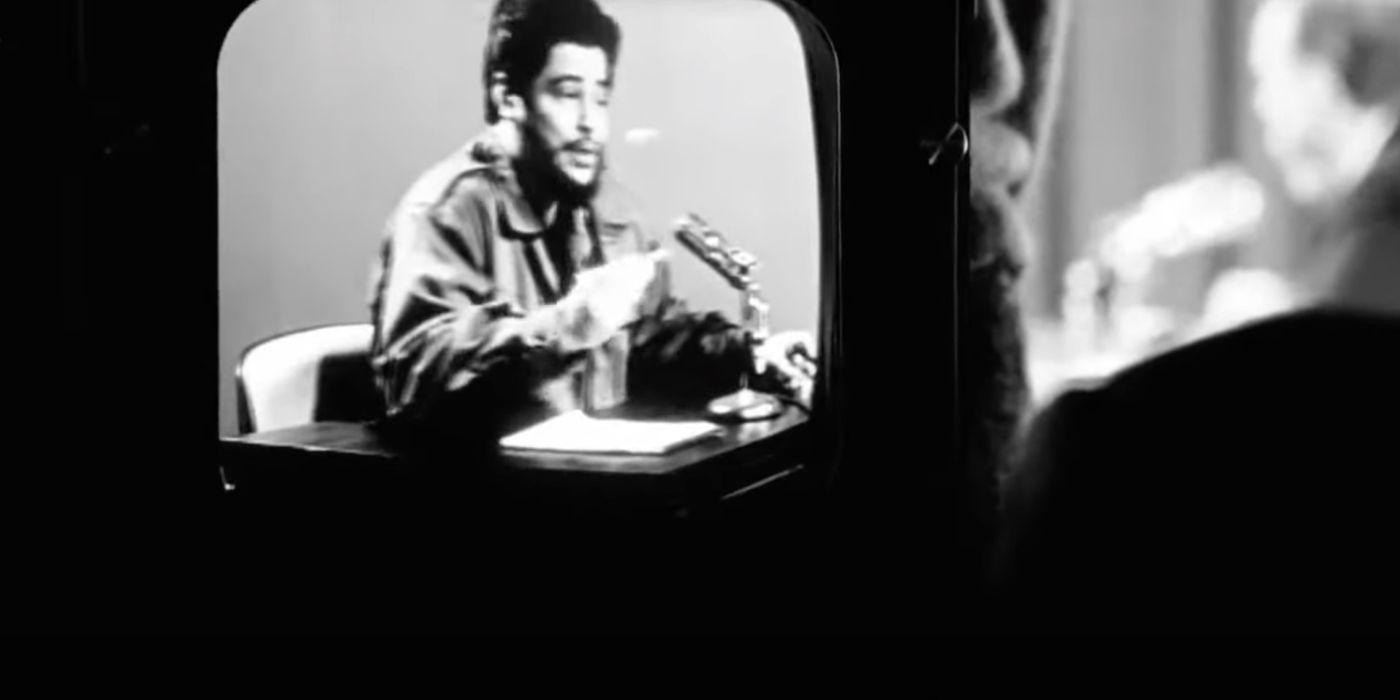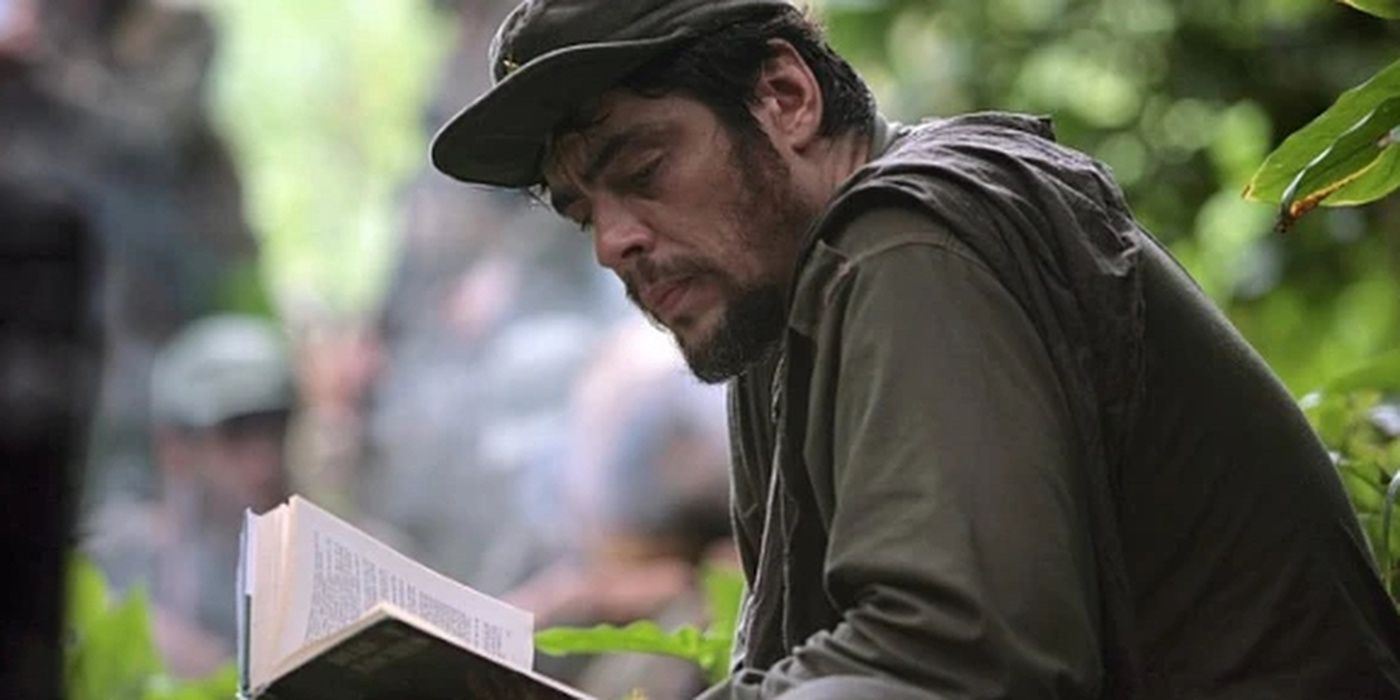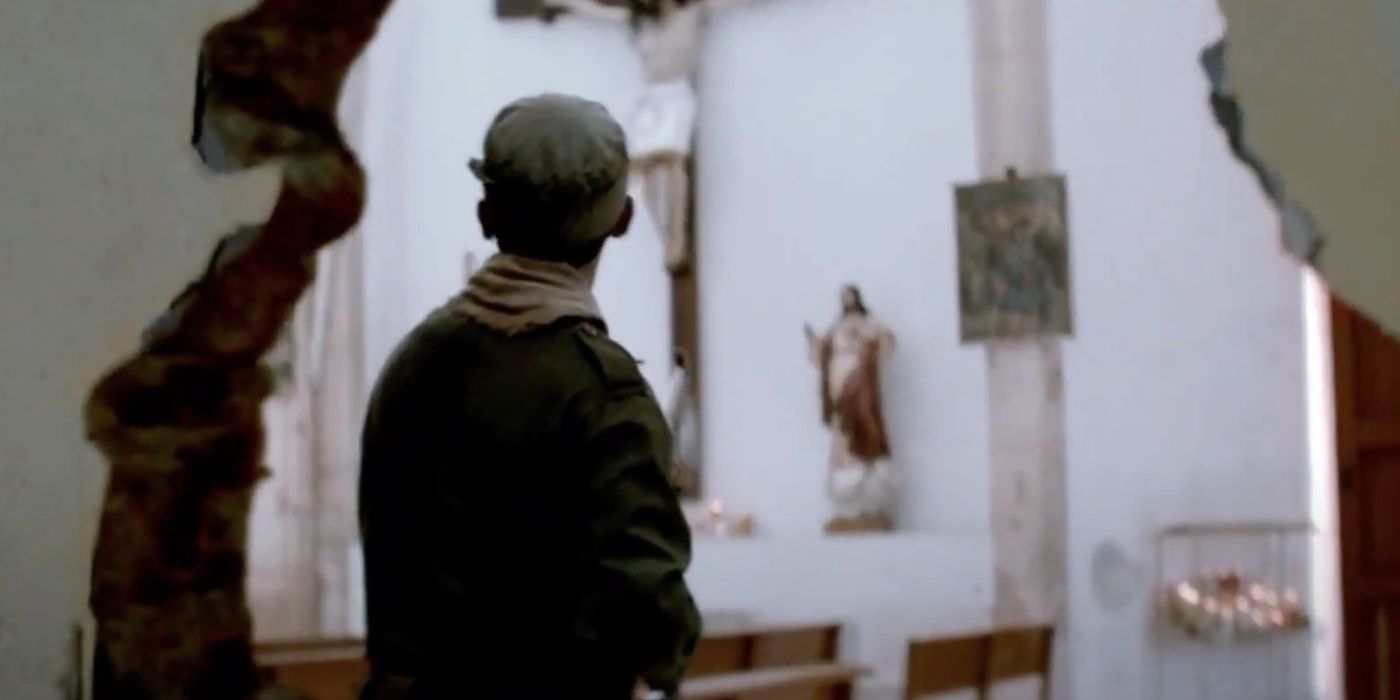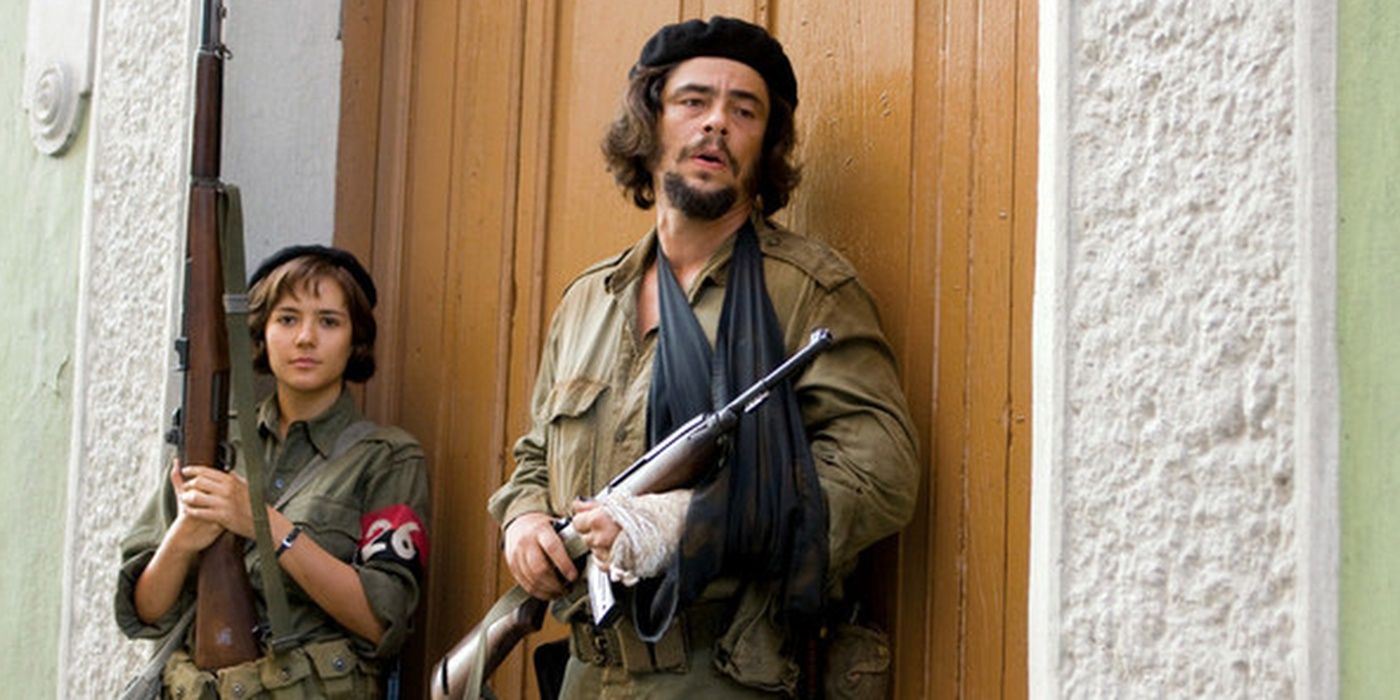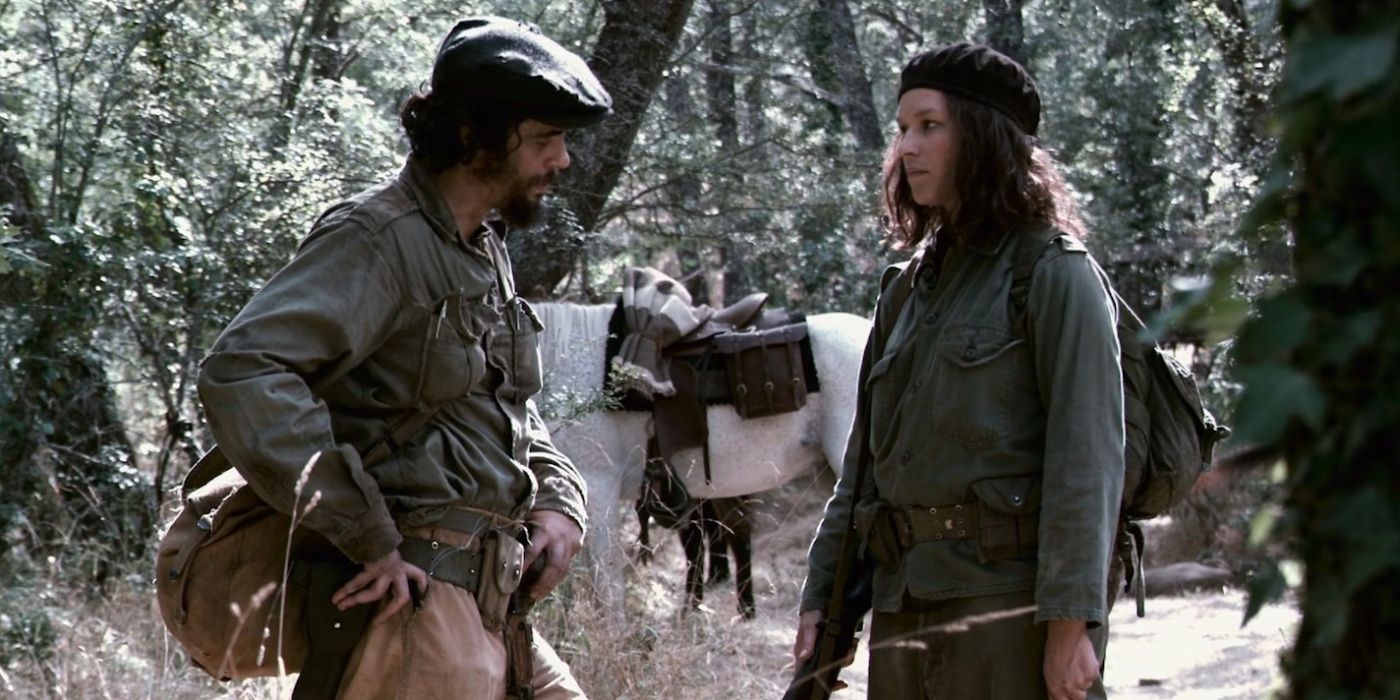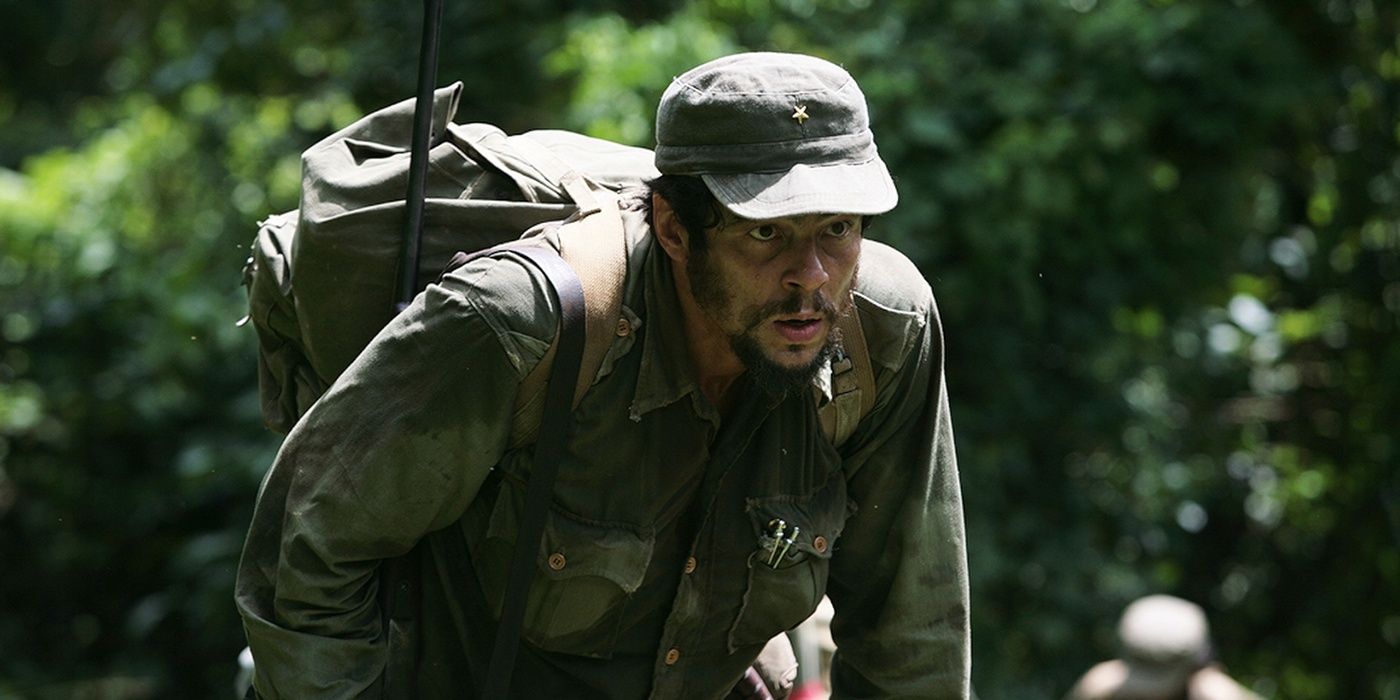
In one of his most challenging roles, he embodied revolutionary leader Che Guevara in the two-part film series titled “Che: Part One” and “Che: Part Two“. This biographical epic was inspired by Guevara’s memoirs, “Reminiscences of the Cuban Revolutionary War “and “The Bolivian Diary“, offering a portrayal of Guevara’s life as he spearheaded revolutionary movements in Cuba and Bolivia throughout the 1950s and 1960s. Today, Che Guevara is recognized globally as a symbol of resistance, with his image appearing on clothing and posters worldwide. His story has been both a target of American defamation campaigns and Soviet propaganda.
It’s challenging to separate truth from myth when evaluating a charismatic politician’s attempts at promoting equality in Latin America, especially since Che Guevara, portrayed by Benicio del Toro and directed by Steven Soderbergh in their two-part film series, is shown as both a heroic figure and one who employed aggressive means to attain his political aspirations. This cinematic duology encourages reflection on the ethics of violence and the appraisal of historical figures’ actions.
History is Far From an Easy Subject to Tackle Cinematically
The Films’ Aesthetic Choices Show How Bias Influences Perception
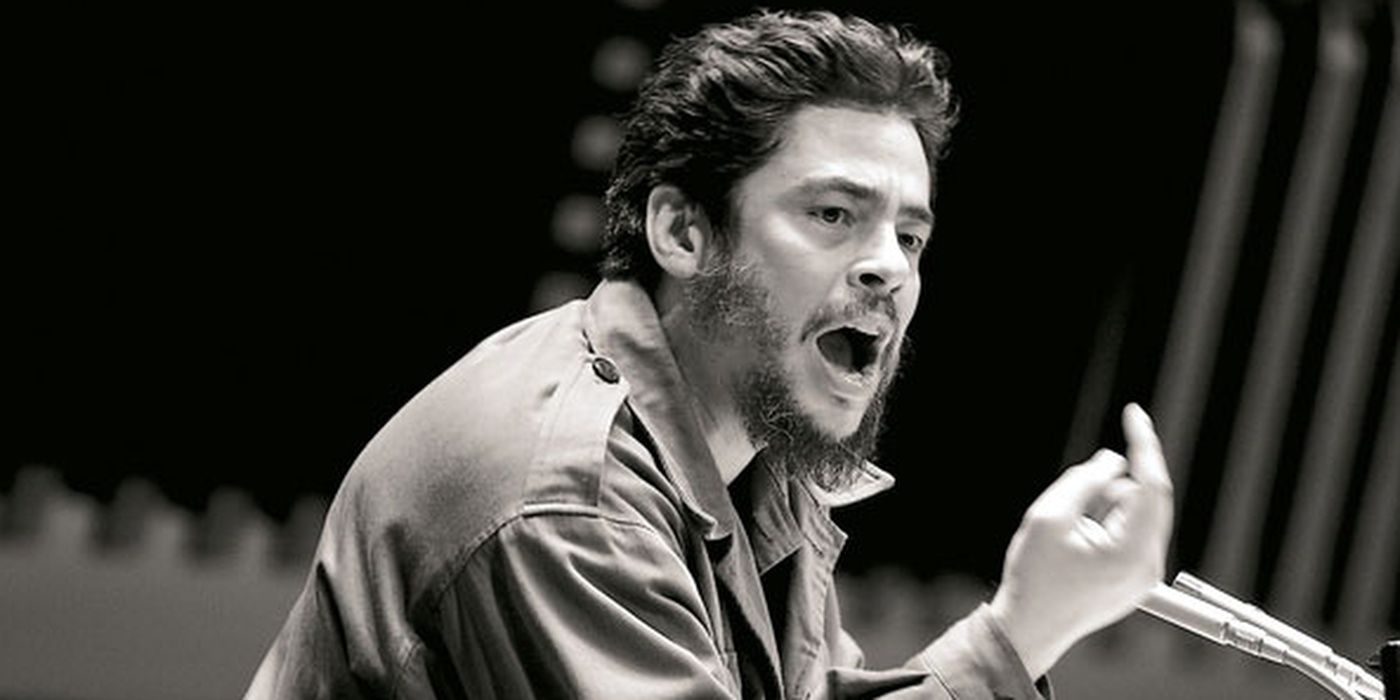
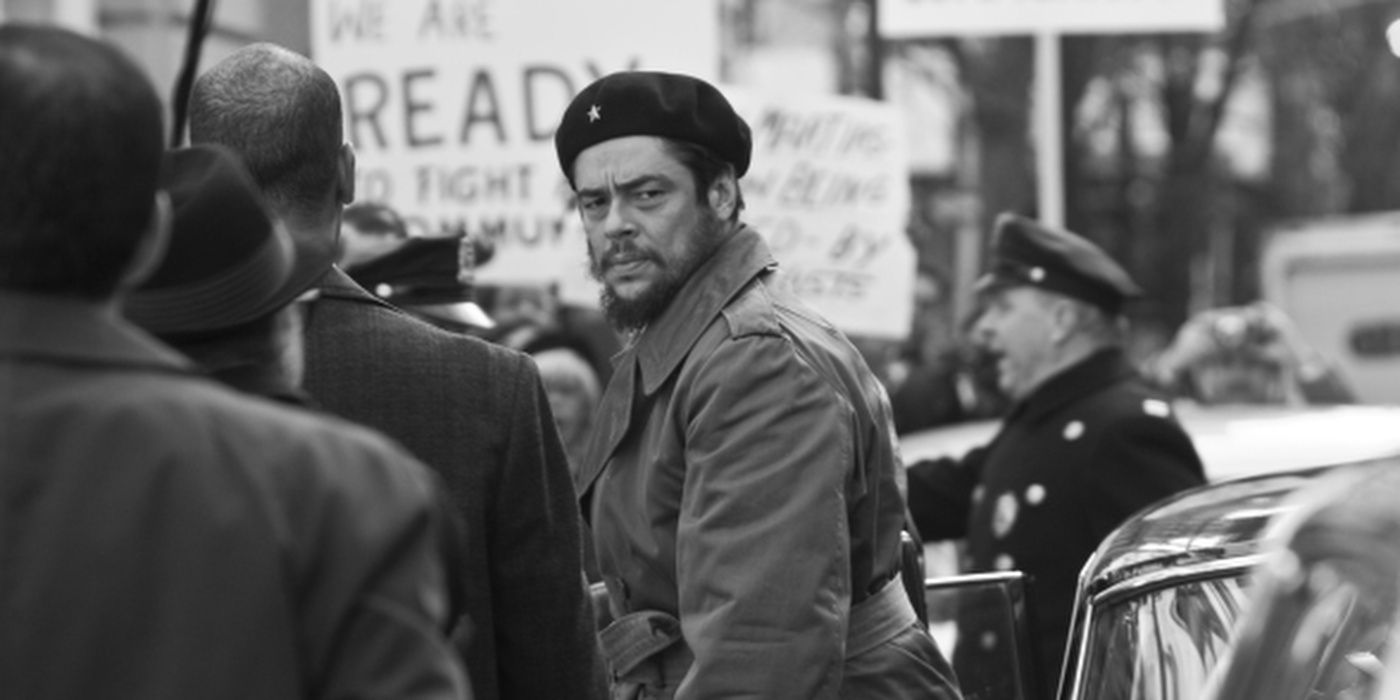
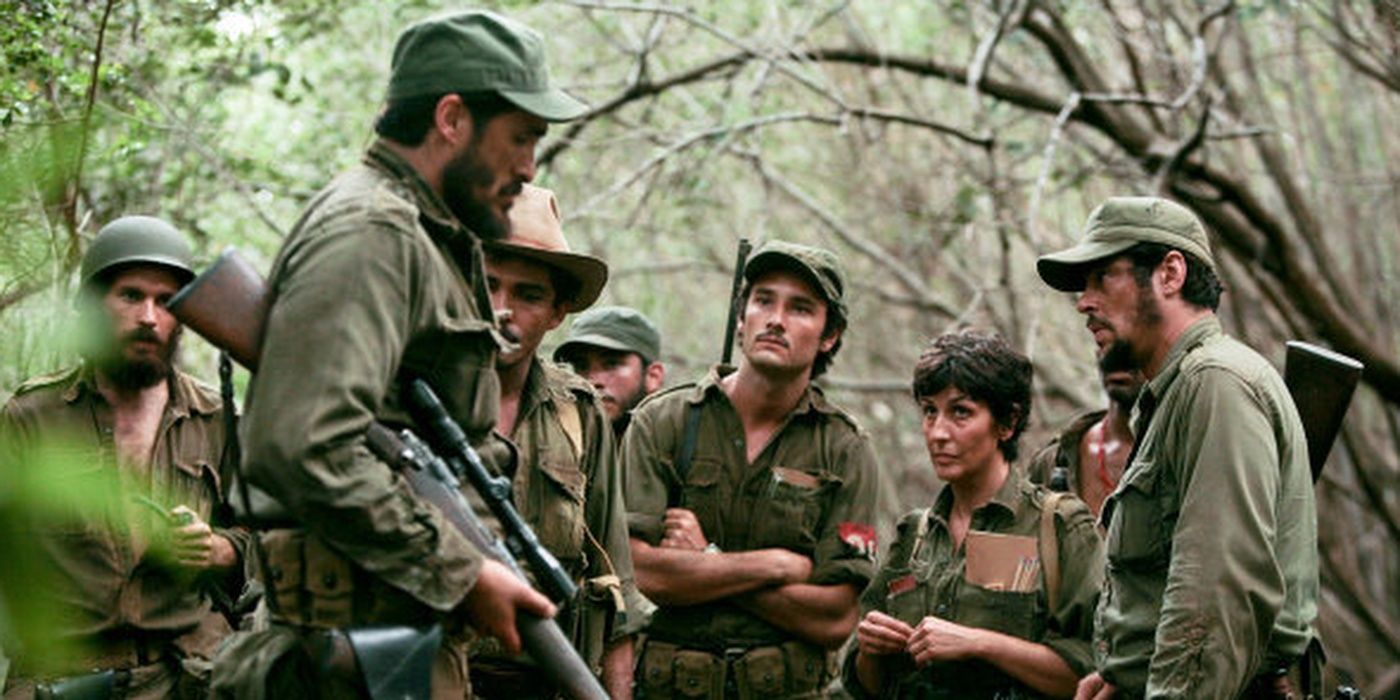
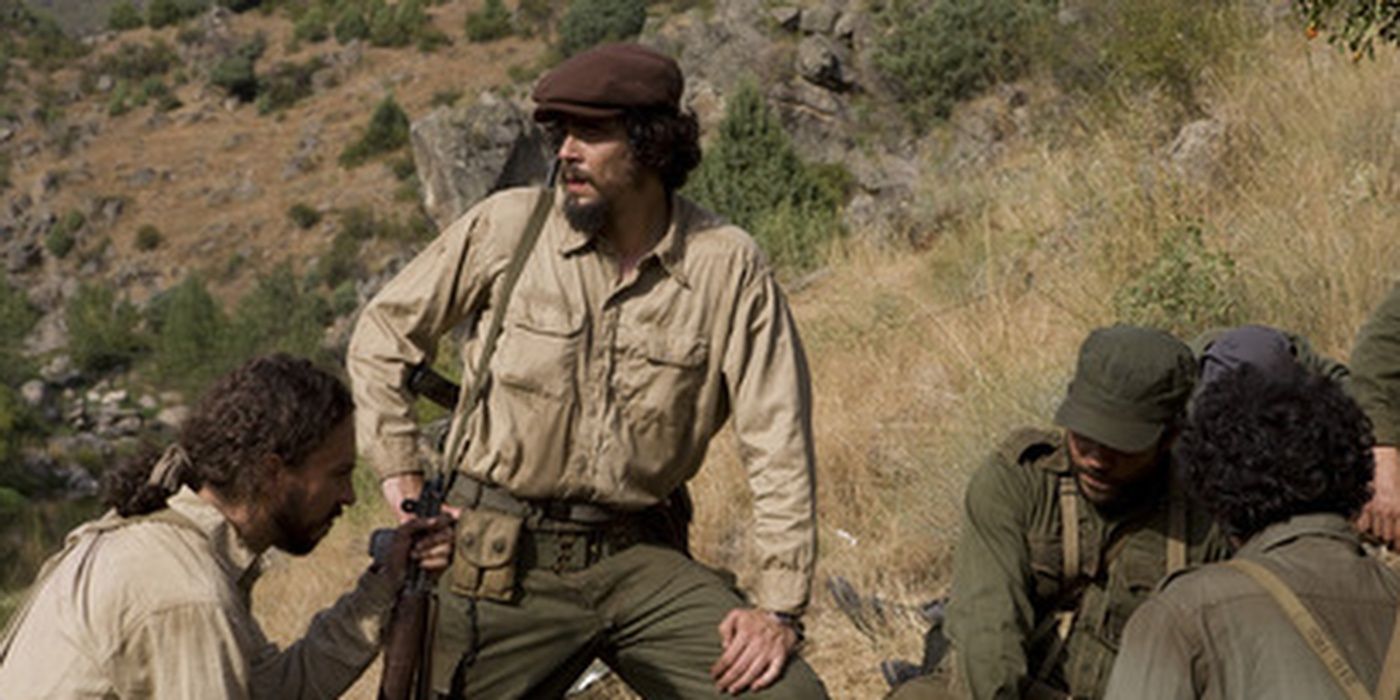
In the movies “Che: Part One” and “Che: Part Two“, Benicio del Toro and Steven Soderbergh effectively portray the complexities involved in studying history, making it clear that individual perspectives and biases significantly shape our understanding of historical events and figures. They accomplish this by employing innovative camera work and recreations of newsreel clips.
In “Che: Part One,” the narrative doesn’t adhere to a straightforward timeline, instead leaping across different timeframes to underscore how public perceptions of events can shift dramatically. This film cleverly juxtaposes vibrant representations of Cuba with stark, newsreel-like scenes from the United States. The Cuban sequences are captured in an immersive, cinematic style, while the American scenes evoke the raw, unfiltered feel of real news or documentary footage. By employing this technique, the film deftly highlights the disparity between Che Guevara as a complex individual and his iconic status as a political symbol.
These films, “Che: Part One” and “Che: Part Two“, demonstrate that it’s hard to grasp the true nature of historical figures or events completely. Key moments are frequently captured from afar or veiled in darkness, denying viewers a clear view of people’s expressions. This cinematographic style underscores how even contemporary happenings can be enveloped in ambiguity and concealed information.
The Che Guevara Film Duology Turns Cameras Into Dangerous Tools
Film & Photography are Memorable Motifs Throughout Both Films
In both “Che: Part One” and “Che: Part Two,” people frequently capture images of Guevara using cameras, while journalists eagerly attempt to record interviews with him. Moreover, the Bolivian army is excited to photograph Guevara upon his capture at the end of “Che.” The significance of film and photography across these films underscores their role in influencing public opinion about political figures.
Through a blend of authentic footage and recreations, Che underscores the potential power of cameras as instruments for inspiring and controlling narratives. In both films, Che: Part One and Che: Part Two, Guevara and his comrades utilized cameras to chronicle their experiences among the underprivileged populace of Cuba and Bolivia. This documentation served to preserve the stories of individuals who had been overlooked and wronged by the wider world.
In the second part of “Che”, the movie starts off powerfully with grim, black-and-white scenes showing Bolivian miners enduring harsh conditions in tin mines. These poignant images stimulate empathy, helping viewers grasp why Che Guevara was driven to rally resistance forces in Bolivia. The opening sets a somber tone, as it becomes tragically real when miners are slaughtered at the Siglo XX mine, marking the deadliest worker massacre in Bolivian history.
Guevara is a Complicated & Multifaceted Figure Perfect for Cinema
The Films Capture the Moral Complexity of the Revolutionary Leader
The Che film series skillfully captures the complexity of Ernesto Guevara, a man who was not only a revolutionary but also a doctor serving the underprivileged in Cuba and Bolivia. Education played a significant role in his ideology, with literacy and numeracy being essential for those under his leadership. The films further depict Guevara’s vision of an idealized Latin America, as reflected in the structured nature of the encampments he established.
In Che’s camps, there were schools, hospitals, and various facilities that fostered a thriving, well-educated populace. Benicio del Toro’s Che films beautifully illustrate the complexities of Guevara’s existence. Though he passionately advocated for healthcare advancements and education, he didn’t shy away from asserting his power using force when necessary.
The movie portrays Guevara carrying out swift punishments on deserters and being ruthless against adversaries. However, it also sheds light on the brutal actions of both the Cuban and Bolivian governments, supported by the U.S., suggesting that the harsh conditions pushed Guevara and his companions to respond in kind. It can be tempting to judge history as black and white, with people being labeled good or evil. Nevertheless, the “Che” duology skillfully illustrates the morally ambiguous side of Guevara’s character.
The Che Duology Continues to Impress With Its Action Sequences
High-Stakes and Quick-Thinking Make for Thrilling Battles
In “Che: Part One” and “Che: Part Two,” the intense battle scenes are filmed in such a way that viewers seem to be immersed directly into the heat of combat. This is achieved by employing shaky, handheld camera work during the fight sequences, which lends an authenticity to these moments. The camera often trails behind a soldier or is placed near the soldiers’ faces, resulting in a feeling for the audience that they are following Guevara’s troops closely. This filming technique fosters a sense of closeness with the soldiers and increases emotional impact during the action scenes, inspiring compassion for Guevara’s troops as they confront their fates.
Long-range shots depict commanders conversing quietly at a distance, evoking the tension that soldiers may have experienced while anticipating instructions. The duology portrays the difficulties of transporting troops through the dense forests and urban landscapes of Cuba and Bolivia. Navigating the jungle, Guevara’s soldiers find themselves persistently outmaneuvered by their adversaries. At all times, there is a palpable feeling of peril as Guevara and his troops seek refuge or swiftly move among trees.
The Women in Guevara’s Life Deserved More Screen-Time
Aleida March & Hilda Gadea Should Have Had a More Prominent Role in the Story
One potential issue with Benicio del Toro’s Che duology lies in its portrayal of the women who significantly impacted Guevara’s life. For instance, Hilda Gadea, his first wife and a prominent communist leader in Peru, is merely mentioned but not shown in either movie. She had a considerable influence on shaping Guevara’s political beliefs. Meanwhile, Aleida March, his second wife, plays a crucial role in the climactic battle scene of the film, where Guevara’s forces clash with the Cuban army in Santa Clara. However, March is only briefly seen at the start of Che: Part Two.
By joining together, “Che: Part One” and “Che: Part Two” span over four hours, and some scenes seem repetitive, driving home the same points excessively. Allocating additional focus on Gadea and March could have alleviated this redundancy, providing insights into Guevara’s personality that can’t be displayed during battle scenes. A unique aspect of these war films is their portrayal of complex historical events, but the extensive information required to cover these events may have led to reduced screen time for March and Gadea in the narrative.
Guevara Faces the Challenges of Modern Warfare
Both Films Show How Revolutions Are Never Simple
In a simpler and more conversational style, the two films titled “Che: Part One” and “Che: Part Two” delve into the intricate aspects of 20th century warfare and politics. It’s evident that Guevara aimed to unite Latin Americans as a collective. However, in “Che: Part Two“, we see how Bolivian villagers and soldiers perceived Guevara and his companions as outsiders. The concept of a united Latin America was too abstract to inspire immediate action. Additionally, both movies portray the disputes between Guevara and other leaders regarding the distribution of land and resources following the revolution.
The movies illustrate that leading a war and governing a nation are two distinct undertakings. The rigid system and discipline that served Guevara’s forces well in Cuba led to dissatisfaction and disillusionment among his troops in Bolivia. Che: Part One and Che: Part Two demonstrate how advancements in technology can reshape warfare and politics on a global level. In Cuba and Bolivia, propaganda via television and radio was employed to disseminate false information, turning the populace against Guevara.
In Bolivia, locals were warned that Guevara and his comrades would only bring devastation and demise. Backed by the U.S. military, the Bolivian army had access to helicopters and cutting-edge weapons from the Vietnam War era to combat Guevara. In crafting the two-part biopic Che, Benicio del Toro and Steven Soderbergh aimed to steer clear of portraying Che Guevara as either a martyr or a villain.
In these films, Che Guevara skillfully navigates the thin divide, demonstrating how his vision of an improved life for Latin Americans fueled his relentless pursuit of this dream, no matter the cost. The audience is invited to ponder whether Guevara’s vision of a just future was worth sacrificing lives for. The daunting obstacles that Guevara and his soldiers overcame during both movies offer a compelling depiction of idealism confronting the harshness of reality. In essence, the films Che: Part One and Che: Part Two present Guevara not as a hero or villain, but as a complex figure whose actions are open to interpretation.
Much like many significant historical figures, Guevera occupies a gray area. The portrayals of Guevera in various films serve as an intriguing examination of the moral dilemmas inherent in humanity, demonstrating how individuals subjected to oppression may be driven to extreme measures just to endure. By emphasizing the commendable aspects of Guevera’s life, such as his dedication towards improving healthcare and education across Latin America, these films delve into the essence of leadership and the role of an agent for positive change.
Read More
- Clash Royale Best Boss Bandit Champion decks
- Mobile Legends November 2025 Leaks: Upcoming new heroes, skins, events and more
- The John Wick spinoff ‘Ballerina’ slays with style, but its dialogue has two left feet
- Delta Force Best Settings and Sensitivity Guide
- Kingdom Rush Battles Tower Tier List
- PUBG Mobile or BGMI A16 Royale Pass Leaks: Upcoming skins and rewards
- Stocks stay snoozy as Moody’s drops U.S. credit—guess we’re all just waiting for the crash
- Bentley Delivers Largest Fleet of Bespoke Flying Spurs to Galaxy Macau
- Vampire’s Fall 2 redeem codes and how to use them (June 2025)
- ‘Australia’s Most Sexually Active Woman’ Annie Knight reveals her shock plans for the future – after being hospitalised for sleeping with 583 men in a single day
2025-04-29 04:39
